Trending
Opinion: How will Project 2025 impact game developers?
The Heritage Foundation's manifesto for the possible next administration could do great harm to many, including large portions of the game development community.

Featured Blog | This community-written post highlights the best of what the game industry has to offer. Read more like it on the Game Developer Blogs or learn how to Submit Your Own Blog Post
Erich Schaefer and Travis Baldree reveal the tricks they used to make Rebel Galaxy appear larger than it really is, and discuss their reasoning for developing a traditional product in space choked with microtransactions and free-to-play games.

Chapter 1: Downsizing
Chapter 2: Driving in the Dark
Chapter 3: Smoke and Mirrors
Head-on Collision
Space is vast, beautiful, and full of wonder. What space is not full of is, surprisingly, stuff. Even factoring in planets, stars, asteroids, and gas particles, space is largely empty. Erich Schaefer learned just how barren space really is when he came across an article published on The Atlantic in late 2014.
“I was just reading something that had nothing to do with our game, and somebody was saying that if you flew from earth in a straight line, the chances of you ever hitting everything are, like, zero. You’ll never run into any planet, or asteroid, or anything. The chances of you hitting anything are infinitesimal.”
The science behind the scenario intrigued Erich. Essentially, it’s easy to believe that a spacecraft traveling in a straight line would eventually run into an obstruction. After all, the universe is infinite, so an object moving on a set path would almost have to run into something eventually, right? Not so. According to physicist, scientific writer, and bowler-hat wearer Matthew Francis, even the largest object is tiny relative to the enormous scale of galaxies. And compared to the universe, even galaxies are small, like grains of sand in a jar.
Erich couldn’t help smiling. “Our game is the opposite: you’ll run into stuff.”
Objects are Smaller Than They Appear
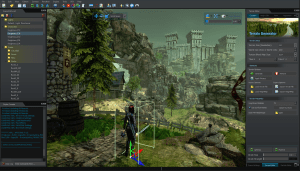
Ogre editing environment.
Unlike a straight shot up through earth’s atmosphere and into the galaxy beyond, Rebel Galaxy’s development did not proceed in linear fashion. Near the start of their journey, Travis came to a fork in the road. One path, that of proprietary technology, was only half paved. Travis had written a game engine built on DirectX 9 tech, and had fashioned the game’s prototypes on that foundation. But finishing a proprietary engine would have tacked months, even years, onto development. Travis and Erich were a two-man team, and Travis was the sole programmer.
They headed down the second, much more convenient path: licensing a pre-existing engine. They knew just where to find one. While at Runic Games, Travis had downloaded Ogre, an open-source engine that anyone can use to build games. Short for Object-Oriented Graphics Rendering Engine, Ogre includes a wide variety of tools and support documentation—almost everything a small team needs to get their game up and running.
Travis had taken full advantage of the toolset while at Runic, reshaping Ogre to fit the needs of “Spaceteam” and, later, Hob. To expedite the making of Rebel Galaxy, he and Erich approached their former business partners and negotiated a deal that allowed them to borrow and expand on Runic’s heavily modified Ogre engine. In exchange, Travis would lend his expertise free of charge if or when his former colleagues hit snags working on Hob. True to his word, Travis sent updated versions of the engine back to Runic each time he made significant changes, such as optimizing Rebel Galaxy to run on PlayStation 4 and Xbox One (due out in early 2016).
With engine in hand, Travis and Erich turned their attention toward defining the look and feel of Rebel Galaxy. They knew approximately what they wanted: a black canvas on which to paint stars, planets, grimy space stations, and nebulas bursting with pinks and blues and purples. “We both knew we wanted it to be colorful, and some of that is practical,” Travis explained. “It’s hard to see things against a black background. You can’t see the silhouettes of ships off in the distance [against a black background]. But some of that was slightly more: it needed to feel real.”
Rebel Galaxy’s colorful environs, as well as the modified game engine that displays them, are two of the many mirrors in Double Damage’s elaborate funhouse setup. Travis is a jack of all game-development trades, but painstakingly crafting galaxies by hand was far out of his wheelhouse. Smart and savvy indie developers know when to undertake tasks themselves, and when to delegate. Corporate giants like Activision Blizzard and Electronic Arts may have pockets deep enough to hire dozens of artists able to paint nebulas and asteroid fields, but most indies—even the ones responsible for Diablo and the most successful of its ilk—do not.
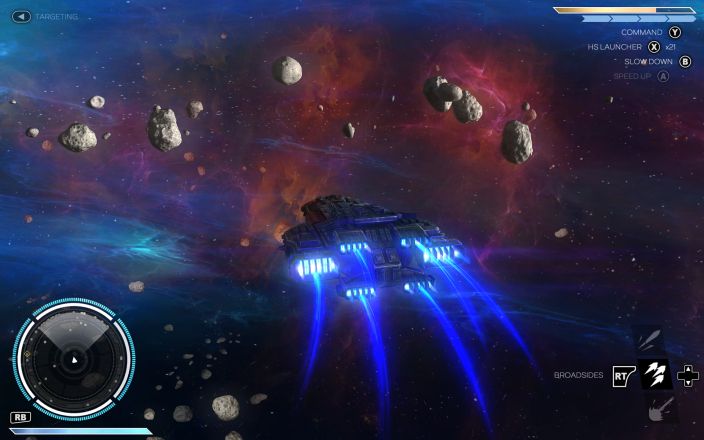
Nebula artwork, created by artist Tyler Young.
Instead of cobbling together star fields that might bring down the quality of their game, they hired Tyler Young, an artist who specializes in painting galaxies and other space settings. The contract between Double Damage and Young was simple, and beneficial to both parties. Young received an hourly wage to create nebula artwork, and Double Damage could feature it in Rebel Galaxy. Additionaly, Young was granted exclusive rights to any work he created for the space sim, meaning he was free to repurpose it for other projects.
Part of what makes Young’s space art appealing is his sense of scale. His paintings look three-dimensional, as if one could reach through them and keep reaching, further and further back, past stars and swirling nebulas to the farthest corners of the galaxy. Over several months of work, he produced art that induced an overwhelming feeling of awe in players upon entering Rebel Galaxy for the first time. In each solar system, gas hangs like mist, and planets loom in the background, surrounded by smaller objects—rocks, gas, and plenty of space junk like containers bearing weapons and artifacts.
Crossing Rebel Galaxy’s stellar vistas takes time, so much so that Erich and Travis added variable speeds and warp drives to the capital ships players can buy. Those speeds, combined with Tyler Young’s vibrant solar systems, help to mask Rebel Galaxy’s true scale. “The little solar systems are much smaller,” Erich said. “I think they’re probably Bay Area-sized, or small-state-sized at best.”
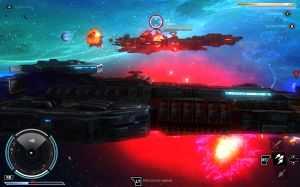
In Rebel Galaxy, planets are close together, much closer than they are in the real universe, and the sun in each galaxy is smaller than a star would need to be to heat most planets. The trick, Erich explained, was to make the game world feel huge. Rebel Galaxy spans over a dozen systems, and each system presents greater challenges. An overarching narrative comprised of missions and activities helps players determine when they’re ready to move on to a new sector.
And although players are captains of their own ships, capricious events may conspire against them. Pirates might answer distress beacons and gang up against players, contraband may drift out of the wreckage of defeated ships, ripe for the taking, and asteroids that happened to float between players and their opponents could serve as makeshift barriers behind which to recharge shields and rethink plans of attack.
“So [Rebel Galaxy] is not huge in scale, nowhere near the scale of Elite: Dangerous or EVE Online, but it feels really big,” Erich said. “It feels like stuff is really happening, like there’s all kinds of people out there who are doing their own things. They’re having their own battles; they’re running their own cargo missions. I think that gives it a big-world feel.”
“It just has to be good enough,” Travis Baldree chimed in. “There’s my spirit of compromise: it has to be good enough to do what I want it to do; to get the effect I need. It doesn’t need to be real. I think a lot of people want things to be real. If you’re simulating a system on a starship, they really want someone with simulated fuel flow. But I don’t care. I just don’t care. I only want the result, and I want enough smoke and mirrors that I can pretend that those things happen.”
Of course, even the biggest virtual galaxy must have limits. Boarding a space ship and setting sail in any direction seems enticing on paper. In practice, implementing such a possibility would pose a significant challenge at best, especially for a two-person team. At worst, it would result in chaos—a rambling virtual reality that most players would find frustrating and confusing.
“None of the decisions you could make about all the things you could do between here and there would be meaningful because there would be so much mess around you in all directions,” Travis explained.
Their solution was to constrain player movement to a plane. Players rotate their ship, point it toward something interesting—a space station, the flash of lasers fire off in the distance, a yellow cone signifying a mission objective—and crank the throttle. Compressing the galaxy and confining the player’s ship to a plane ensures that they will collide with an object eventually, without sacrificing the sheer density of goodies and activities that a space-faring game is expected to offer.
The alternative, Travis said, was a capacious world teeming with interesting things that always hovered just above or below the player’s line of sight. “Suddenly, being able to fly around and explore, and come across things, becomes doable. I think that really works to the advantage of the game. I don’t think there’s a great way to do that when you can fly in any direction.”
Restricting movement did not impede the naval combat system Travis worked so hard to define and polish. Indeed, limited movement enhanced encounters. If players had to align their ship with hostile vessels and account for their vehicle’s pitch, the naval-like combat would be cumbersome rather than strategic.
“Besides, all those games exist,” Travis reasoned. “If people want to play a game where you can pitch and roll and fly all over the place, you’ve got Elite: Dangerous, and it does that great. I don’t need to make that; that game exists. We’re making a game that doesn’t actually exist. That’s great, from my perspective.”
Backbone
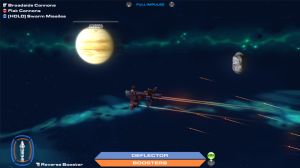
You can take the designer out of procedurally generated dungeons, but you can’t take procedurally generated dungeons out of the designer. As in their panoply of action-RPG hits, Erich and Travis employed carefully honed algorithms to create unique environments in Rebel Galaxy that no two captains will ever traverse.
As with the game’s artwork, Travis opted to use a readymade solution for creating games set in deep space rather than procedurally reinvent the wheel. His tool of choice: Accrete, an open-source program that creates simulations of solar system. The simulation works by creating a star meant to represent a sun, wrapping a dust cloud around it, populating the surrounding area with objects able to generate dust, and then spawning planets by way of accretion—stacking on more and more layers. The end result: a rambling system bedecked in galactic trimmings.
“I have sort of a modified version of that that generates semi-legit solar systems,” Travis said. “It’s all based on a seed trigger where I mess around with it a lot. And obviously our distances make no sense whatsoever.”
Distance is a minor detail in Rebel Galaxy. Again, Travis’s and Erich’s goal is to create the illusion of size. Toward that end, Travis refined his algorithms to check and double check certain qualifiers. First, a unit of measurement to properly chart the string of galaxies that make up their world. The truth, however, is that Rebel Galaxy’s unit of measurement exists more to enhance the game’s sense of authenticity than for any practical purpose.
“Here’s a little secret, too, that I should not mention because it might ruin the fun,” Erich confided. “We talk in terms of stellar meters. SM is our unit of scale. But, really, those were kilometers forever. At the very end, halfway through development, we just turned them into SMs instead of KMs.”
Travis weighed in, saying: “You can call them stellar miles, or solar miles, or solar meters, or space meters—it doesn’t matter, but everybody always thinks it means one of those things.”
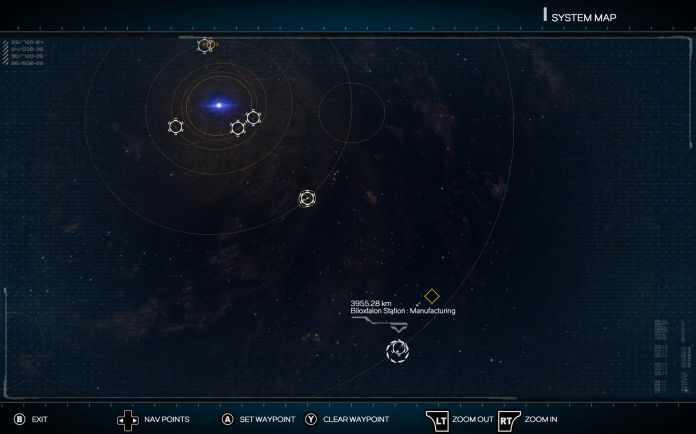
Next, algorithms populate each and every SM with interesting features. Erich and Travis define “feature” as matter such as nebulas, planets, debris fields, and other objects one would expect to find drifting through the cosmos. Once again, exploration and adventure trump realistic physics and other such pesky considerations. “Those hand-crafted features get distributed based on rules,” Travis explained. “Ice fields can only appear in places where it’s at least this cold. None of [the rules] make any sense, obviously. Another rule is that if we have a magma planet, I have a heat region around it where it likes hot stuff: you get obsidian asteroids. That makes no sense. Space is not hot. But it worked for my purposes.”
In the original Diablo, certain monsters and environmental geometry were placed according to specific conditions. If algorithms selected, say, the Butcher side quest for players to complete, the game had to find a place to stick the Butcher’s blood-splattered lair somewhere on Level 2. Rebel Galaxy’s algorithms work in the same way. Each solar system includes a set of loose rules baked into its algorithm that describes the difficulty of its missions and combat scenarios relative to other galaxies, what types of activities (such as side missions) are available, and locations related to the main storyline that players follow.
“In a lot of ways, it’s like the randomized stuff we’ve done before; it’s just got different rules, and it’s a lot more freeform,” Travis said. “There’s less of a specific backbone.”
That lack of rigidity affords Erich and Travis more freedom in scattering features. “There’s probably a thousand or so in each solar system, so probably 13,000 features [total], which is a heck of a lot; even though space is smaller than [what would be realistic], there’s a ton of stuff out there,” Erich said.
No Place Like Home
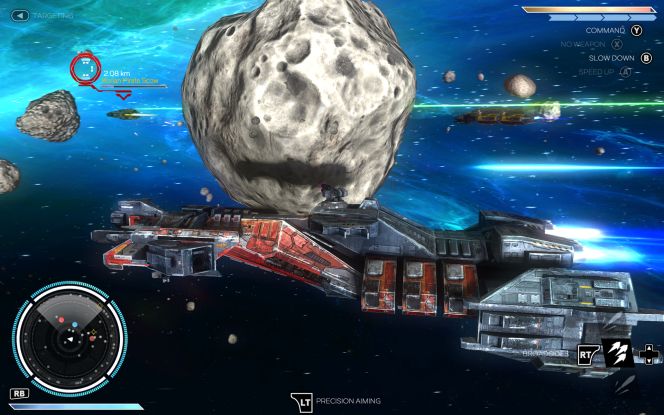
Strategic use of an asteroid.
The combination of variety in features, as well as the certainty that players will run into them by flying in any direction, has instilled Rebel Galaxy with a homey sort of vibe present in the industry’s best games. Elements such as color palettes, deep mechanics, and the emotions triggered by recognizing telltale signs, enable players to form bonds with game worlds that last a lifetime. Diablo possessed these elements in spades: from the wounded peasant who lay bleeding outside the entrance to the cathedral, signaling the presence of the Butcher lurking down in the dungeons, to the opening chords of Matt Uelmen’s soothing yet haunting melody that plays each time players set foot in Tristram.
Those same chords played when players returned to the beleaguered town in Diablo II. As they battled the monsters responsible for plundering Tristram and discovered the corpses of old friends, the familiar tune shifted, growing more somber and surreal. Many players found themselves profoundly affected by the experience of revisiting Tristram. To those who had spent dozens (even hundreds) of hours wandering between its warmly lit buildings and bartering with its inhabitants, seeing Tristram burned and gutted was like returning to their hometown only to find a parking lot where their childhood home once stood.
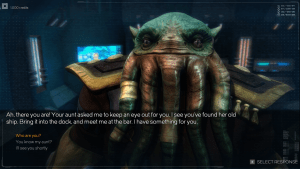
“That was also another lesson I learned from the Hellgate: London stuff,” Erich admitted. “I think we made a really neat game in a lot of respects, but it wasn’t a game you wanted to live in. It wasn’t comfortable and fun. It was interesting and tactical, but it didn’t really have a ‘Hey, this is a place I would want to live’ [vibe]. I think we hit that to some degree, as much as we can for a little game like ours. It is kind of like, ‘If I was a space captain, this is where I’d want to hang out.'”
To make Rebel Galaxy a game where players would want to hang their captain hats, Erich and Travis ran every feature, mission, ship, and upgrade through a single filter: personality. One way many videogames establish personality is by writing a compelling narrative—plot twists and character reveals that pull players onward through the game like a fish caught on a hook. Yet neither Double Damage co-founder puts much stock in spinning yarns for players to unravel. In fact, Travis recounted occasions where designers at Runic grew frustrated with him for hand-waving away their questions concerning Torchlight’s lore. He didn’t care about story; he just wanted to create fun gameplay.
That said, he understands how storytelling and game mechanics can work in tandem to pull players deeper into a world. “I like character more than story, but it’s almost impossible for a game to have character without some story to help carry it. How do you have people to talk to if you don’t give them something to talk about? I want to feel like there are characters out there and stuff going on; that I’m not just in this machine designed to entertain me for a little while.”
Travis had certain goals in mind when he set out to spin Rebel Galaxy’s tale. The through line involves players attempting to track down their aunt, who gifted them with an old ship and then disappeared. But Travis’s larger narrative goal was simple. He wanted to be a space pirate. He wanted to meet interesting people and aliens, converse with them, and maybe align with or swindle them, depending on his mood and what he felt like doing in the game.
Above all, he wanted Rebel Galaxy to be the player’s story. Events should revolve around players’ objectives and what they choose to do, rather than chain them to the narrative track.
As they search for their aunt and make friends and enemies, players shape the world according to their whims in myriad ways. When conversing with NPCs, they can choose from different responses that evoke certain tones, such as helpful or aggressive. In one early mission, players are asked to retrieve an item from an NPC voyaging far from a space station. Upon tracking down the item’s keeper, they can ask for it nicely, or go hostile, triggering an impromptu battle. In another scenario, players might save a merchant under attack from a band of pirates. Maybe the merchant will give them a reward as thanks, maybe they won’t—in which case, players could opt to open fire, crack open the hull, and side what goodies spill out.
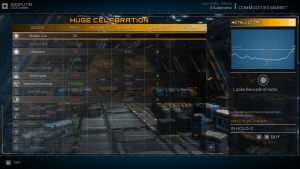
Given that broadside combat is the keystone in Rebel Galaxy’s genetic makeup, Travis designed most of the game’s story-focused missions around encounters. Others see players tracking down NPCs and artifacts in far-flung corners of space, escorting ships, and exploring. Travis created each mission type from a template. Each time he finished a template for a mission type that players would experience in the main story, Erich stepped in to fulfill his role as designer.
“I would take that dynamic, an escort-type of mission, and turn it into random missions, and we’ve got maybe 20 to 30 of these escort missions in the game. I would create new circumstances—new people to have to escort around, new enemies to fight while we’re doing so—so I would take the dynamics he would make for these story missions and turn them into random missions.” Erich estimated that he produced approximately 99 percent of the side missions in Rebel Galaxy.
Most of the side missions can be found in space stations that post jobs for players to complete. Others are found simply by flowing around and bumping into events that the algorithm sprinkled in among the stars. Giving players lots to do was one of Erich’s primary goals. He and Travis enjoy playing EVE Online, a science fiction MMO known for the staggering size of its virtual universe. However, neither of them care for the fact that players can float around for long periods without anything to do. They spent the first four to six months of Rebel Galaxy’s development figuring out how densely packed their take on space should be.
Their verdict: the more stuff to do, the better. Ideally, they agreed, players should be in the thick of a mission, only to spot some distraction that piques their interest: a firefight between groups of ships, asteroids ripe for mining, factors that offer a plethora of rewards for players who decide to fly their banner, or a distress beacon from another ship. “We wanted it to feel like you’re not in the blackness of space, but that you’re in this colorful, weird, nebula stuff all the time,” Erich said. “That was the plan from the beginning.” (continued below)
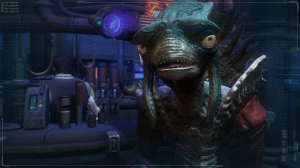
Putting on his writing hat, Travis scripted lines of dialogue for every NPC in the game—humans and otherwise. He took special steps to give the extraterrestrials unique dialects. “All the aliens are me. I’m literally every alien in the game. I would just sit down, look at what I’d written in English, and then I would talk over it. I’d usually do a revision or two where I’d find common words like ‘be’ and ‘and’ or whatever, and try to make sure they were the same phonetically, and then I’d [talk] again. It was all very seat-of-the-pants.”
Aboard the player’s ship, a dulcet, female voice broadcasts messages such as changes in speed and the proximity of nearby objects. The female voice that issues notifications and alerts to players on board their ships was supplied by Baldree’s wife.
(continued from above)
Another part of Erich’s job involved making it worthwhile for players to stray off the beaten path. “Is it a good idea to go check out that distress signal? I try to pretty much make sure that, yeah, it always pays off to check that stuff out. That’s the way we tried to make [space] feel alive. The other thing is the art direction: keep it really colorful, make areas look different from other areas.”
As for the diversions themselves, the Double Damage co-founders sought to hit every touchpoint of space opera and science fiction adventures. They wanted to design the ultimate scoundrel simulator, a world in which players could become so notorious as to put Han Solo himself to shame. As Erich worked with his templates to extrapolate hundreds of side missions, Travis plugged away at game systems—an economy that responded to the player’s actions, enabling them to buy low and sell high; mercenaries that players can hire to bring extra firepower into particularly tough encounters; opportunities to smuggle and sell contraband for surplus profits—all toward the goal of stuffing Rebel Galaxy’s stelliferous skies chockful of interesting things to do and places to explore.
“It’s like when you play FPS, and you walk down the hall and all the doors are locked,” Travis said. “You say, ‘There’s nothing on the other side of those doors,’ but if at least a certain percentage of those doors can be opened and you can go one room deep, it extends your feeling of the place. It feels less like just a hallway you’re walking down, and more like a building you can explore. I think Rebel Galaxy works that way in a lots of ways.”
Setting Sail
On September 15, 2015, Double Damage Games issued a press release stating that Rebel Galaxy would take flight on PC on October 20 via digital platforms Steam and GOG.com. The announcement included a quote from Travis confirming that he and Erich had more fun designing the game than they’d had on their previous projects. He also admitted that they were excited and “a little nervous” to hand their game, which had been a pet project for nearly three years, over to the public.
Their nerves were understandable. Creative individuals often spend years, even decades, nurturing ideas into tangible products. Naturally, they bond they share with their creation grows over time; many creatives liken their books, movies, games, paintings, and other brainchildren to literal children. Seeing those brainchildren leave the nest and enter a world where they will either be accepted or ripped to shreds is a terrifying proposition.
Yet Travis’s quote was appropriate: he and Erich felt only “a little nervous” about the impending release. “I feel like we’re going to do fine,” Travis told me. “I think it’s going to be okay. I think it helps that we’re not making something that exists right now. Like, ‘Hey, we’re making a survival game with zombies!’ If we did that, I think we would be doomed. If we made a Minecraft-alike; if we tried to ape some other thing that’s hot. We’re probably not going to be doing a lot of pixel-art games that hearken back to 16-bit graphics.”
Erich agreed, explaining that despite their modest team size and budget, none of their pre-release jitters stemmed from concerns over whether or not Rebel Galaxy would be financially successful. “If we don’t make any money from it, that’s okay,” Erich said matter-of-factly. “We paid ourselves salaries while we made the game, and we would just go on to the next thing. We wouldn’t get into [financial] trouble even if no one buys the game ever; we’re going to be fine, and we’ll start on our next game. But if anyone buys it, it’s a plus for us. We’re pretty happy.”

A major reason for Erich’s and Travis’s satisfaction during Rebel Galaxy’s development resulted from the fact they were content in their work. Unlike developers working for corporations whose shareholders expect them to blindly follow industry trends and profitable models, Erich and Travis retain the autonomy to follow their whims. “I just want to make games that I want to play,” Erich said. “This definitely fits that mold: this is the space game I want to play. And I don’t want to be nickel-and-dimed for DLC all the time. I don’t mind the free-to-play model; there are some games like that that I do play. But when I picture the perfect games for me, they’re never the free-to-play model; they’re always, the 40-to-50-dollar, super-cool products like the Blizzard games we used to make.”
Viewing the industry through a Rebel Galaxy-tinted lens, Travis believes other developers aspiring to create new types of games can and will follow the path he and Erich took. “I like the idea that people can go back to being indies. That you can go back to the idea of a very small group of people, or even a person, making a game. I would also like there to be a lot of ambition combined with that. I like games like The Long Dark. That’s a small team doing interesting stuff; I like seeing that, and I’d like to see more and more of that.”
By the time I spoke with Erich and Travis on October 7, less than two weeks out from Rebel Galaxy’s launch date, the game was “pretty much done,” according to its creators. “We certainly don’t go into idle mode,” Travis said. You’re always just waiting for something to go wrong. It’s not like the old days where you sent it off to production, went home and got drunk, and then, two days later, it would end up in a store, and if you had a problem with the game, could just say, ‘Well, I don’t know. I guess that’s it.’ Now, if something goes wrong, you’ve got to be on it.”
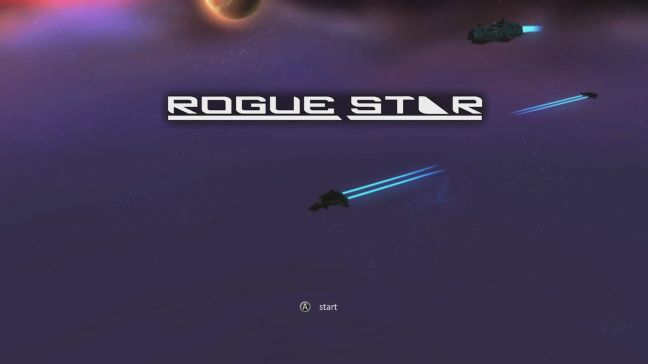
One working title for “Spacegame,” which became Rebel Galaxy.
While Travis makes tiny adjustments to the code, Erich seizes the opportunity to open spreadsheets and make minute adjustments to numbers that correspond to damage, credits given as rewards for completing missions, and other data. Closing the spreadsheets for the final time, he gave Travis the go-ahead to send digital review copies to critics and streamers on Twitch and YouTube. “That’s always a weird feeling. Well, now this thing’s done. We’ll see if people like it. Now what am I supposed to do with my life?”
Erich admitted that he doesn’t exactly look forward to seeing reactions—like most creatives, he only sees warts on complexions that fans and critics may praise as flawless or close enough—but that he has to. “I’d almost rather just disappear, go to some Pacific island and come back in six months to see what happened. We definitely have to keep an eye on it right now. We still have a couple of weeks to iron out some problems, and see if people break our game somehow, and see if we have to fix it.”
Nothing Else Like It
Price at $19.99, Rebel Galaxy dropped on October 20. The first wave of reviews followed hot on its heels. IGN editor Dan Stapleton tapped into the spirit Erich and Travis hoped to bring out in their players: “It brought out my inner Han Solo for a great space adventure,” wrote Stapleton, who awarded the game an 8 out of 10 and lauded the cowboy-bluesy soundtrack, “cinematic starship combat,” and open-ended design.
PC Gamer’s Christopher Livingston needed some time to warm up to the broadside combat. Once it clicked, he declared Rebel Galaxy “a grind, yes, but an enjoyable one.”
While most reviews landed in the 70-to-80 range, fans looking for a new space romp to scratch their Privateer itch flocked to the game. Less than 24 hours after its release, Rebel Galaxy ascended to Steam’s coveted #1 bestseller position. As of late December 2015, it is rated “Very Positive” on Steam based on over 1,555 user-submitted reviews, and holds an average of 4.5 out of 5 on GOG.com, an aggregate compiled from more than 170 user-submitted votes. (continued below)
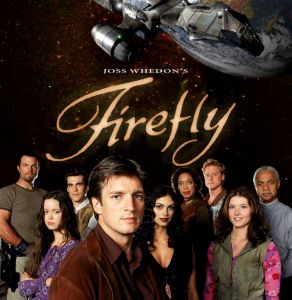
Open practically any review of Rebel Galaxy, and the critic probably compares it to Firefly at least once. Some players might find it surprising, even sinful, that of all the touchstones Erich and Travis referenced while spec’ing out Rebel Galaxy, Firefly didn’t come up once.
“A lot of people specifically mention Firefly, and ask if we [chose the music] to be Firefly-like,” Travis admitted. “The answer is actually no. It ended up getting some of that feel, but it was not any conscious decision to make Firefly, space western-y-ness. There’s probably more of a Sons of Anarchy vibe than Firefly.”
Erich echoed his partner’s response, stating that Firefly was perhaps the only sci-fi world they didn’t draw from. “We took a little of Star Trek, a little of Star Wars, all those kinds of [universes]. Everybody says it’s kind of Firefly-esque, but honestly, I never watched the show. I watched the movie Serenity and just didn’t like it at all, which is too bad, because a lot of our fans are big Firefly fans. But it’s just a happy coincidence that they’re so similar.”
(continued from above)
More than two months since the game rocketed onto PC hard drives, Erich and Travis still haven’t shifted into what Travis described as “idle mode.” They spend hours each day responding to questions, comments, and requests for technical support on forums like the /r/RebelGalaxysubreddit, the @RebelGalaxy Twitter page, and on rebel-galaxy.com. When possible, they go above and beyond to help players get the most out of their experience.
“So this game owns and the dev working on it also owns,” wrote Shacknews.com forum member Geoffris, who spent his Halloween playing Rebel Galaxy. “My save file got corrupted today. I looked around forums and couldn’t make it work. So I emailed the dev directly. Guy answered super fast [sic], but said he couldn’t do anything with my save file. So I described where I was and he built me a save file so I could continue. Had just hit the second system so starting from scratch would have sucked.”
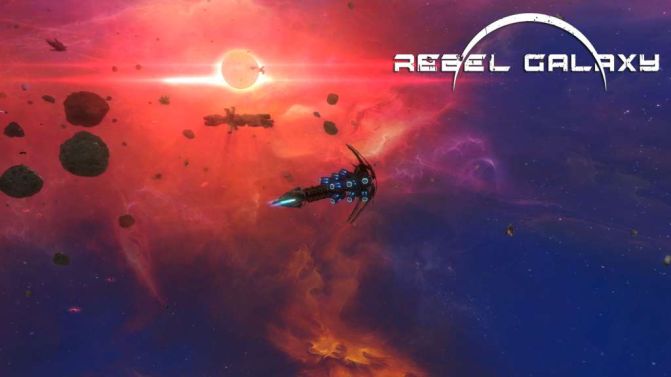
When they’re not jumping through hyperspace to help their players enjoy their procedurally generated galaxies, Erich and Travis cruise around Rebel Galaxy—to iron out bugs and roll out patches, yes, but also just for fun.
“I think developing our combat system is the most fun I’ve had making anything, ever, because I felt like I was doing something that hadn’t ever been done before. And it worked out!” Travis said. “It didn’t end up being a total abject failure. It has great properties you can’t get anywhere else. I thought that was a lot of fun. Apart from that mechanical part of the job, the experience of getting this blues music, and these goofy, rubber-mask aliens—it has this pulpy, B-movie feel that I’ve enjoyed messing with, and it doesn’t have any swords. There are no swords, no goblins—this is great.”
“That’s why I love this two-man development team: I can do those things without having to explain what I’m doing to anyone else; without having to ask people to do it for me,” Erich agreed. “I love playing it, and modifying it and tweaking it on the fly without having to explain what I’m doing to anyone on the time. That’s what I love. It’s just a great, day-to-day process for me.”
**
Visit Episodic Content for more serialized stories about game design and culture, and subscribe to my Patreon to show your support for my writing.
Bibliography
* According to physicist, scientific writer, and bowler-hat wearer: “The Chance of a Collision in Outer Space Is Practically Zilch.” The Atlantic.http://www.theatlantic.com/technology/archive/2014/12/the-chance-of-a-collision-in-outer-space-is-practically-zilch/383810/.
* He also admitted that they were excited: “PC Release Date Announced! October 20th, 2015.” Rebel-Galaxy.com. http://rebel-galaxy.com/pc-release-date-announced-october-20th-2015/.
* IGN editor Dan Stapleton tapped into the spirit: “Rebel Galaxy Review.” IGN.com. http://www.ign.com/articles/2015/10/16/rebel-galaxy-review.
* PC Gamer’s Christopher Livingston needed some time to warm up: “Rebel Galaxy.” PCGamer.com. http://www.pcgamer.com/rebel-galaxy-review/.
* Rebel Galaxy ascended to Steam’s coveted: “Steam’s Latest Hit Is Basically Firefly: The Video Game.” Kotaku.com.http://steamed.kotaku.com/steams-latest-hit-is-basically-firefly-the-video-game-1737907000.
* As of late December 2015, it is rated “Very Positive” on Steam: “Rebel Galaxy.” SteamPowered.com.http://store.steampowered.com/app/290300/.
* and holds an average of 4.5 out of 5 on GOG.com: “Rebel Galaxy.” GOG.com. http://www.gog.com/game/rebel_galaxy.
* “So this game owns and the dev working on it: “Shacknews.” Shacknews.com. http://www.shacknews.com/chatty?id=34139743#item_34139743.
Read more about:
Featured BlogsYou May Also Like